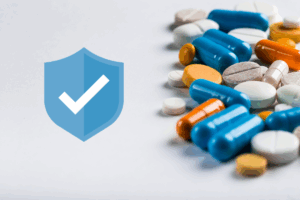The expiration of the Humira® (adalimumab) patent has been long and enthusiastically anticipated and is finally upon us in 2023. And, as we all have expected, the introduction of biosimilars for this product is proving to be extremely complex. The FDA has already approved several biosimilars for Humira®, but they are sitting in various positions for market launch due to ongoing litigation, supply constraints, and legal settlements with Humira®’s manufacturer.
Product Formulation and Interchangeability
Product formulation and interchangeability are major points of focus for Humira® biosimilars because the drug exists as the same dose in two concentrations: 40mg/0.8mL and 40mg/0.4mL. In 2018, Abbvie began selling the high concentration product, formulated without the citrate buffer, making the injection less painful. This formulation led to a renewed marketing campaign for Humira, successfully convincing patients and providers to switch to the high concentration product. It may have been Abbvie’s goal to create barriers to biosimilar competition with this strategy, but almost all Humira® biosimilar manufacturers have cleared the hurdle, developing low and high concentration formulas without the citrate buffer. Patients and providers may be unaware of this and thus push back against biosimilars, so patient and provider education will be important to the success of the biosimilars in the marketplace.
The next consideration is interchangeability. Most state laws allow a pharmacist to substitute an interchangeable biosimilar for the original brand, so it’s advantageous for any biosimilar to have interchangeability status. Right now, it looks like we’ll see one low concentration product, Amjevita®, launch without interchangeability status on January 31, 2023; it will enjoy standard market exclusivity until July of 2023. Due to its lack of interchangeability status, uptake of Amjevita® may be more complex as pharmacists must coordinate with prescribers to make the switch from Humira. Thus far, there is only one Humira biosimilar product that’s been awarded interchangeability status—a low concentration product called Cyltezo®. Several other manufacturers—including high and low concentration products— are awaiting decisions from the FDA on interchangeability. Pfizer expects approval of interchangeability for their low concentration product, Abrilada®, by year-end 2022, and Alvotech/Teva’s high concentration product is in the running for FDA approval and interchangeability status with a target launch date of July 1, 2023.
Copay Card Programs
Another major factor in the success of the biosimilar rollout of Humira® will be copay card programs. For better or worse, they are an integral part of the pharmacy experience and strongly influence patient behavior. If the biosimilar products don’t launch with copay card programs equal to those of Humira®’s, patients will most certainly resist the change to a biosimilar. Or, a biosimilar-only formulary coupled with a less-than-desirable copay card program may lead patients to switch to a completely different product with a better copay card program, likely at a higher cost to the plan.
Formulary Placement
The biggest factor for National CooperativeRx’s book of business in the realm of Humira biosimilars will be formulary placement of the products on CVS’ specialty formulary. There are three main formulary possibilities. Abbvie, Humira®’s manufacturer, may offer CVS a contract to keep branded Humira as a preferred product, at a lower net cost than a biosimilar, and exclude any biosimilars. This contract may come as a bundled package along with Skyrizi® and Rinvoq®, two of Abbvie’s other main products. For example, there could be improved pricing or rebates for all three products as long as they’re all kept in preferred formulary status. A consequence of rejecting a biosimilar in favor of a branded product package is that the rationale for the strategy may not feel transparent to patients or the public. However, this strategy is quite common in the non-specialty space. Patients stay on the branded product, resulting in less disruption, and the plan’s net cost is lower. Another risk with this strategy is, despite being beneficial in the short-term, this option may not be sustainable as biosimilar prices erode over time and may provide more cost-savings than Abbvie may be willing to provide for the brand.
The second possibility is that CVS gives Humira® and its biosimilars equal, or parity, formulary status. Optum and ESI have announced this is the formulary strategy they will deploy. This is probably the most palatable option for patients as they can choose which product results in a lower cost for them, and once there is broad interchangeability status, pharmacists can substitute the products to facilitate patient preference. The major drawback here is that uptake of the biosimilar would likely be low, especially for existing users, as most patients are averse to change unless it will cost them more to stay on the brand. Most biosimilar utilizers would likely be those who are new to treatment with adalimumab.
The final possibility is a “biosimilar only” formulary which excludes Humira®. While this may seem like the most logical option, it would be the most disruptive to patients and prescribers, at least until there are more interchangeable products. There may be less immediate cost savings to plans and patients due to the low number of biosimilars in the market initially. And as mentioned above, some patients are extremely resistant to any generic or biosimilar and may switch to a different and more expensive product to avoid it. As more biosimilars come to market, the prices come down and prescribers gain confidence in using them, we may see increased uptake and more preferential formulary placement.
Another concern with both the parity and biosimilar-only formulary strategies is that of supply. There is one biosimilar launching on January 1st. Given that Humira® has $20 billion in annual sales with millions of users, it’s unlikely a single biosimilar manufacturer could handle the demand for the drug alone. As we see more products come to market later in 2023, the risk of supply issues will ease.
The introduction of Humira® biosimilars is sure to shake the market. The interplay of patent litigation, formulation, biosimilar rules and Humira®’s blockbuster status may make this one of the most complex biosimilar situations in history. Earlier this year, Abbvie expected a 45% erosion in Humira® sales in 2023, but a fourth quarter investment call has them confident Humira® will stay on 80% of formularies with equal placement to the biosimilar products1. This likely means plans will see savings on adalimumab via improved pricing on Humira® or through competitively priced biosimilars—or both.
For more information about Adalimumab Biosimilars, click here. 2
- AbbVie Inc. (NYSE:ABBV) 5th Annual Evercore ISI HealthCONx Conference Call November 29, 2022 10:55 AM ET. Accessed November 29, 2022. https://seekingalpha.com/article/4561180-abbvie-inc-abbv-5th-annual-evercore-isi-healthconx-conference-2022-transcript
- Jeremias, S. Part 1: Biosimilars to bring a bumper crop of adalimumab options. AJMC The Center for Biosimilars®. September 6, 2022. Accessed December 6, 2022. https://www.centerforbiosimilars.com/view/part-1-biosimilars-to-bring-a-bumper-crop-of-adalimumab-options




